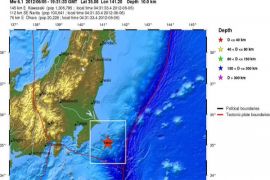The utility company attributed the sharp rise in radiation to radioactive substances floating from Fukushima No.1 nuclear power plant.
The Japanese government on Sunday rated the Fukushima No.1 nuclear power plant at level 4 on an international scale of zero to seven, in a sign that radiation risks are mounting in Japan.
Two radioactive substances, cesium and radioactive iodine, have been detected near the No.1 reactor of the plant, where radiation rose to 882 micro sievert, compared with the legal limit of 500, according to Tokyo Electric Power Co.(TEPOC), operator and owner of the Fukushima plants.
The Fukushima prefectural government said Sunday that 19 more people were found to have been exposed to radioactivity, in addition to three cases of exposure recorded Saturday.
In the neighboring Ibaraki Prefecture, radioactive monitor was set up and no abnormal reading has been obtained so far.
Earlier in the day, the TEPOC reported that the No.3 reactor at the plant lost its ability to cool the reactor core, becoming the sixth reactor that lost the function after No.1 and No.2 reactors at the No. 1 plant and No.1, No.2 and No.4 at the No.2 plant had suffered the same trouble.
Pressure has been successfully released at the reactor following the injection of fresh water, according to the latest Sankei Shimbun report.
At an emergency press conference Sunday, Chief Cabinet Secretary Yukio Edano said that the radiation briefly jumped to 1, 204 micro sievert at the plant.
The top government spokesman warned that there are still 114 people staying within a 10-km radius of the Fukushima No.1 nuclear power plant and 180,000 in the 20-km evacuation zone.
All inhabitants have been removed from a 3-km radius of the No. 2 plant, and authorities have begun evacuating more than 30,000 from a 10-km zone around the plant, he added.
On Saturday an explosion occurred at the Fukushima No. 1 nuclear power plant, destroying the roof and the walls of the building of the No.1 reactor`s outer container.
Four people were injured at the power plant, but radiation levels dropped quickly after surging for a while following the blast.
Edano told reporters said that the TEPOC filled the reactor with sea water and poured in boric acid to prevent an occurrence of criticality.
Authorities said there was no damage to the steel container housing of the troubled No. 1 reactor and the explosion occurred as vapor from the container turned into hydrogen and mixed with outside oxygen.
Also on Saturday authorities expanded the evacuation zone from a 10-km radius for the Fukushima nuclear plants to a 20-km radius.
The Japanese government continued Sunday to wrestle with extensive damage from the great earthquake and ensuing enormous tsunami that hit northeastern and eastern regions Friday.
Also in the day the Japan Meteorological Agency upgraded the magnitude of the devastating quake from 8.8 to 9.0, making it one of the largest recorded in the world.
Police said that more than 2,000 have died or remained unaccounted for so far while the government death toll has risen to almost 800.(*)
(Uu.H-AK/)
Editor: Ruslan Burhani
Copyright © ANTARA 2011








